We work with a budget institution. Part 1
If you are working or are only going to work with a budget institution, this article (as well as the whole cycle) may be useful for you. The customer approached you with a proposal to develop some kind of software for him (sell / assemble computers, take office equipment for maintenance). And this customer is a budget institution. What should I look for? What should beware? Is it possible to somehow minimize the risks of such cooperation? What is the promise of money and why is it not enough? And where is the open data? If you are interested in it - I ask for cat.
Initially, the article was planned as a kind of memo about some of the features of working with budgetary institutions for small IT companies or IT specialists who are individual entrepreneurs, but in the process of writing it turned out that the scope of questions concerned is too wide for both the format of the memo and the format of one article .
With high probability there could be two options:
1. The memo is short and tezisnaya, but understandable only to those who have sufficient training in this area ... and quite useless for all (or almost all) others.
')
2. An article containing an introductory course covering some issues of the legal status of institutions, procurement legislation, civil law, etc., filled with details and background information, examining the issues raised from different points of view and taking into account numerous development options events, but ... lost its relevance in the process of writing (even difficult to imagine how long it will take), swollen to disgrace and causing the overwhelming majority (including the author himself ) Desire to immediately close a tab, and in the few readers pereborovshih this impulse - a sense of irresistible boredom after reading the first two or three chapters.
To avoid this and make the material useful and readable for many, several volitional decisions were made:
1. Do not try to encompass the immense: if one article is not enough to manage - let it be a cycle of articles. The main goal is to give the most clear and realistic representation of the features of working with budgetary institutions; therefore, a detailed explanation of some related issues will have to be neglected and some information should be given as an axiom (or consider such issues in separate articles).
2. Gradualism is the basis of the basics: many questions require, of course, a comprehensive review, but it’s impossible to tell everything at once. Therefore, we will move in stages (article by article), periodically referring to what has already been stated, inevitably simplifying and coarsening something.
3. Boundary conditions: an attempt to describe as many scenarios as possible depending on the type of customer, cost and type of work, some other circumstances looks very tempting, but this is simply unrealistic, therefore we will sometimes move from the particular to the general, and sometimes and vice versa. All that goes beyond the boundary conditions, try to consider another time, actively using comparisons and analogies.
As a result of the above-described volitional decisions, instead of one article, so far we have received acollection of works in fifty-eight volumes about three. Approximately - because there may still be some rearrangement of the material.
Who can it all come in handy? Those who work (or are only going to work) with budgetary institutions.
Will the information be useful for those who work:
1. Under the fixed-term employment contract with a budget institution?
Hardly: in this case, the main role is played by labor legislation. But in order to expand the horizons - why not read?
2. With a budget institution, but whose activities are not related to IT?
Yes. Much of the work with budgetary institutions does not depend on what exactly you are doing, but everywhere there is a specificity and some points relate exclusively to the sphere of IT - keep this in mind.
3. Not with a budget, but with a government, autonomous institution, or even an executive body or local government?
Yes, there is a lot in common. In order not to be constantly distracted by clarifying what kind of customers we are talking about, which would only complicate both writing the article and reading it, it was decided to consider the features of working with them in a separate comparison article (if it will be interesting to readers).
4. Not with a budget, but with a commercial institution?
Information will be useful since the second half of the second article, but still have to take into account the specifics.
5. With a budget institution, but on the basis of an agreement concluded as a result of an auction, tender, request for quotations, request for proposals?
Yes, much of the information will be relevant, but in this case, the specifics associated with the organization, conduct and participation in competitive procedures are added, and, conversely, the process of agreeing the terms of the contract almost disappears. There is a non-zero probability that some interesting points will be considered in a separate article.
Do not forget that each situation is unique in its own way, and to draw analogies, despite the possible similarities (real or only apparent), you must be very careful.
Article is my first publication on Habré, and, accordingly, the first article of the subject concerned. I do not know how much the raised topic will be in demand, so if: you are interested in something; a question has not been considered in sufficient detail and requires additional explanations; you strongly disagree with something - please write in the comments or through personal messages.
It is a little about the author and the reasons for writing the article: I am a longtime reader of Habr, but, as it happens, I registered only now. For all this time, a lot of information was gathered from Habr, which turned out to be not only interesting, but also useful: for professional activities, and for various hobbies, and even for some domestic needs. This information was so much that the recurring idea that it would be nice to somehow “give up” (I don’t like to remain in debt), at some point transformed into an article you see.
Answers to some possible questions are given under the spoiler at the end of the article. Also, under the spoiler, some images have been removed (mostly, visualizing the description of the navigation through the menu of sites) and information: reference (excerpts from the text of laws and other documents) and not related directly to the topic of the article, but related to it.
So, the promised boundary conditions: we will be a budget institution as a customer, a small (or large) company or an entrepreneur as you, software development will be the subject of the contract, and the contract itself will be concluded directly with you, and not as a result of tender, auction or request for quotations (competitive methods of procurement is a topic for a separate conversation), the cost is approximately known, and even the task does not cause any special questions (at first glance).
How to find out the TIN by the name of the customer is not a secret, but for the sake of completeness, this is worth mentioning. The website of the tax inspectorate egrul.nalog.ru can be searched by TIN / OGRN or by the name of the legal entity (IP). Let our customer - the Lower Sortyim Children's Art School Municipal Budget Institution (this and other institutions are completely random and are used solely for the purpose of example).
By clicking on the name of the institution, you can download an extract (.pdf). Usually, the most interesting is contained on the first three or four pages, but nobody forbids to view them all.
Now we have the TIN of the customer (8617013974), the full name of the director, address (location), founders, activities (OKVED), licenses, and so on. Why do we need this?
INN - we will use it for further search queries.
Director’s full name - in order to know with whom we must conclude an agreement (in the third article of the cycle about the importance of having a person concluding an agreement with appropriate powers and possible unpleasant consequences).
Address (location) - firstly, it is always useful to know where the customer can be found (and if the nature of the work you do is related to the physical visit of the customer, then it’s not just useful, but necessary), secondly, we may need this address for exchange of correspondence.
The founder is a higher authority for our customer, and in some cases it will be useful to address there with those problems that the customer cannot or does not want to solve.
And if you want to know more? There are other sources of information, for example, the official website for posting information about state (municipal) institutions bus.gov.ru/pub/home .
Just in case, I provide a link for independent viewing: bus.gov.ru/pub/agency/3071 . On this page are the name of the institution (full and abbreviated), founder, type of institution (do we still remember that we work with a budget institution?), Address, name of the manager, phone number and even a website (of course, the customer’s site does not always have ).
Here are the Charter of the institution, a license for educational activities, an order appointing the director and other documents.
Is this helpful information? Yes of course. In addition to the data obtained from the tax inspectorate website, we now know the type of institution: usually in the name of budgetary institutions there is the word "budget" (the letter "B" in the abbreviation), but it may not be - the law is not prohibited. We also have a Charter where you can gather information about the powers of the institution and its founders, about sources of financial support and other details. The order on the appointment of a director is also a useful document.
Possible problems: not in all institutions (read, municipalities and even regions) due attention is paid to the timely updating of information.
It would seem, what difference does it make to us? If only to pay on time and in full. But this is in theory, but in practice - the source of funding or the source of financial support (as it is called officially) is very important. No one wants to be in a situation where the work is done and successfully delivered, and no one is in a hurry to pay for it. All the variety of reasons for the customer (non-financing costs, took the money for other needs and another 1000 and one) should not be a problem performer. We will talk more about payment issues in the following articles, but for now let's see what you can find out about the presence / absence of funds from the customer.
The budget institution has two main sources of financing: the “budget” and the “extra budget”. The definitions are not entirely correct - therefore in quotes.
The “budget” is the money that the state allocates (yes, the author is aware that local governments are not included in the system of state authorities, but this is easier than writing FOIV, OIV and LSG every time): it can be the budget of a settlement , municipal district, region, region, etc. For budgetary institutions, the main sources of budget funds are subsidies for the implementation of the state (municipal) tasks and subsidies for other purposes.
"Off-budget" is that the customer earned himself: his income from business and other income-generating activities.
And why do we need this? If you are going to work with a budget institution, you need to understand the following:
The “budget” is not real cash held by the customer in the accounts and which he can pay “right now, right now.” These are only planned (and not always) expenses. In other words, for now this is only a promise of the state to give this money to the customer. A promise can be taken back (not to give money) or reconsider (reduce the amount or change its purpose). A customer can try to resist this in an extremely limited number of cases, and even then without a guarantee of success.
"Off-budget" is also not always cash. Sometimes, of course, the customer already has money, but often he still has to earn it, and then this is again a promise: only now it is a promise not of the state, but of the customer. A promise can be ... However, we will not repeat.
The main financial document for a budget institution is the Financial and Business Plan or, in abbreviated form, the PCD plan (there are also agreements on the allocation of subsidies and other documents, but they have nothing to do with our subject). It is signed by the head and chief accountant of the institution, it is approved by the founder, and it contains the promises (of the state and the customer), which we discussed above.
Let us return to the official site already familiar to us for posting information about state (municipal) institutions. If the menu with information about the institution choose
Download the latest version of the Plan of financial and economic activities (we are guided by the date of publication, at the time of this writing, the latest version of 05/27/2016).
In this case, we deal with the .xlsx file (in principle, we could get both .doc, and .pdf, and even .jpg), in which on the sheet “Meas (8)” is the current version of the plan of financial and economic activity:

The income section (starting from line 22) reflects the sources of financing, from which the customer plans to receive money (I emphasize that he plans). Lines 24 and 27 contain information on subsidies for the implementation of municipal tasks and subsidies for other purposes (this is the “budget”).
How do these types of subsidies differ? Directly with the topic of the article is not connected, so who cares - I ask for a spoiler.
Line 29 is the income from entrepreneurial and other income-generating activities (in the subsequent lines there is a detalization), or “extrabudget”.
So, the promises of the state ("budget") - 24042309,13 rubles., The promises of the customer ("off-budget") - 1466280 rubles. A natural question arises: which source of funding is more profitable from the point of view of the performer? There is no exact answer.
The amount of subsidies for the implementation of the municipal task is known, as a rule, from the beginning of the year (it is known to someone in advance, and someone can know for sure their funding, for example, in March), should not change and can not be reduced (although the Prime Minister and said recently that unused money should be taken away), but in practice it happens quite often due to the fact that there is no money.
Subsidies for other purposes have a little more security when they have already been promised (read - they issued a corresponding order or decree), but if they have not yet been issued, they can easily go to other needs or to another customer. If this is a subsidy from a higher budget, then someone can be punished for the non-appropriation of the allocated funds, so they are trying to pay them promptly - again, if there is money.
The customer also needs to earn money from business activities, and in a crisis situation with the “budget”, institutions often have to plug holes in the “extra-budget”. , «» , , , , ( , ).
, , , . - , ( : ), (, ). , , . , .
, , — . , , .
— ( 1 2013 . N 65 « »). , , base.garant.ru/70408460/5 , ( «»). , :
1) — 225;
2) — 225;
3) — 310;
4) — 340;
5) — 226;
6) — 320.
, , . : , ; ( ); .
: , — 320, ( , , ), 226. 226 . , .
, . , ( 225), ( 310), ( 226). , , , , , , — .
: , — 226.
. «» ( 47) :
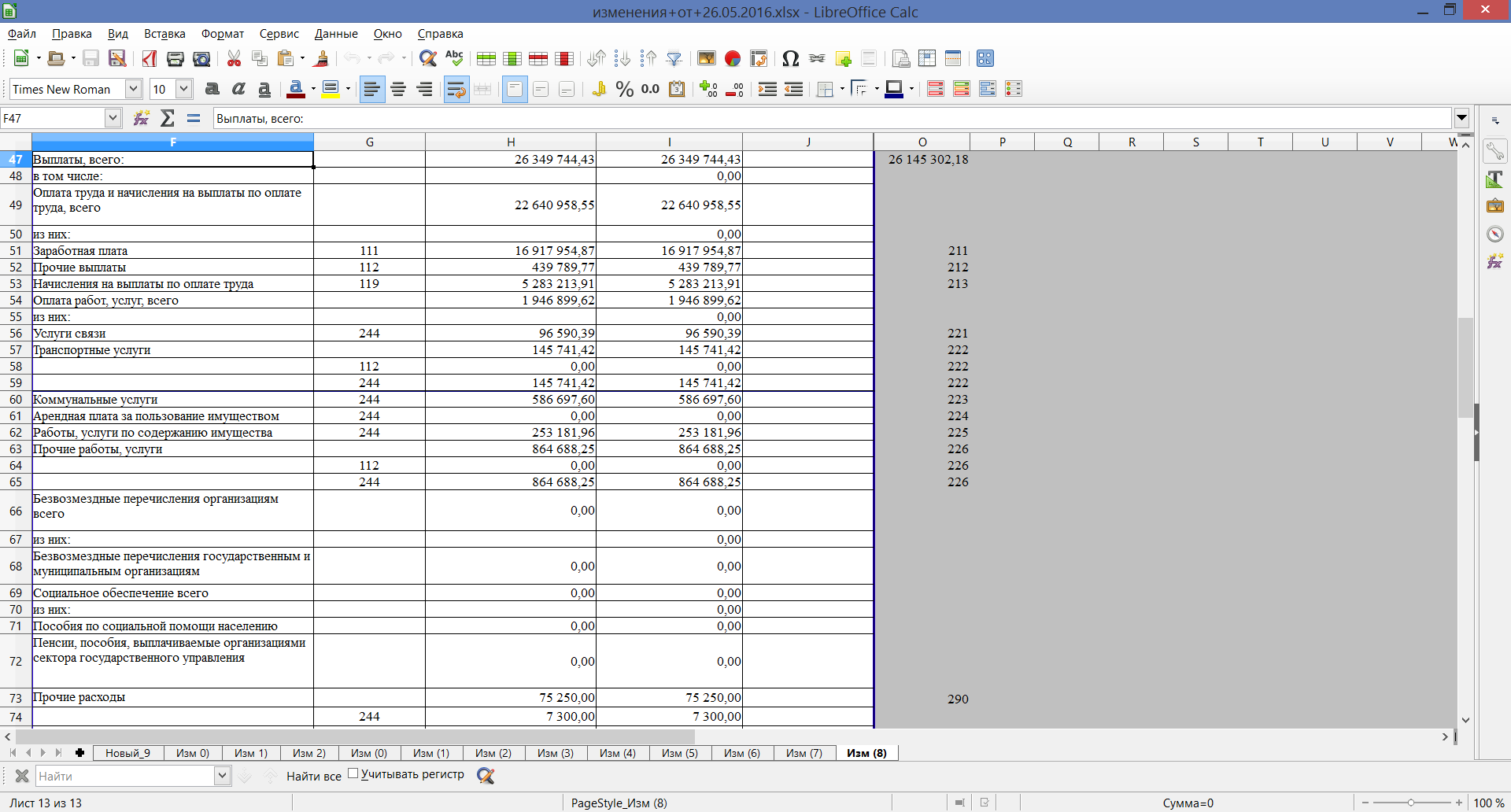
«O» . , ( «F»).
, (, , — ), ( ), «» «». , 226 ( 65). , , .
.
( , ). — 5514008737. , :
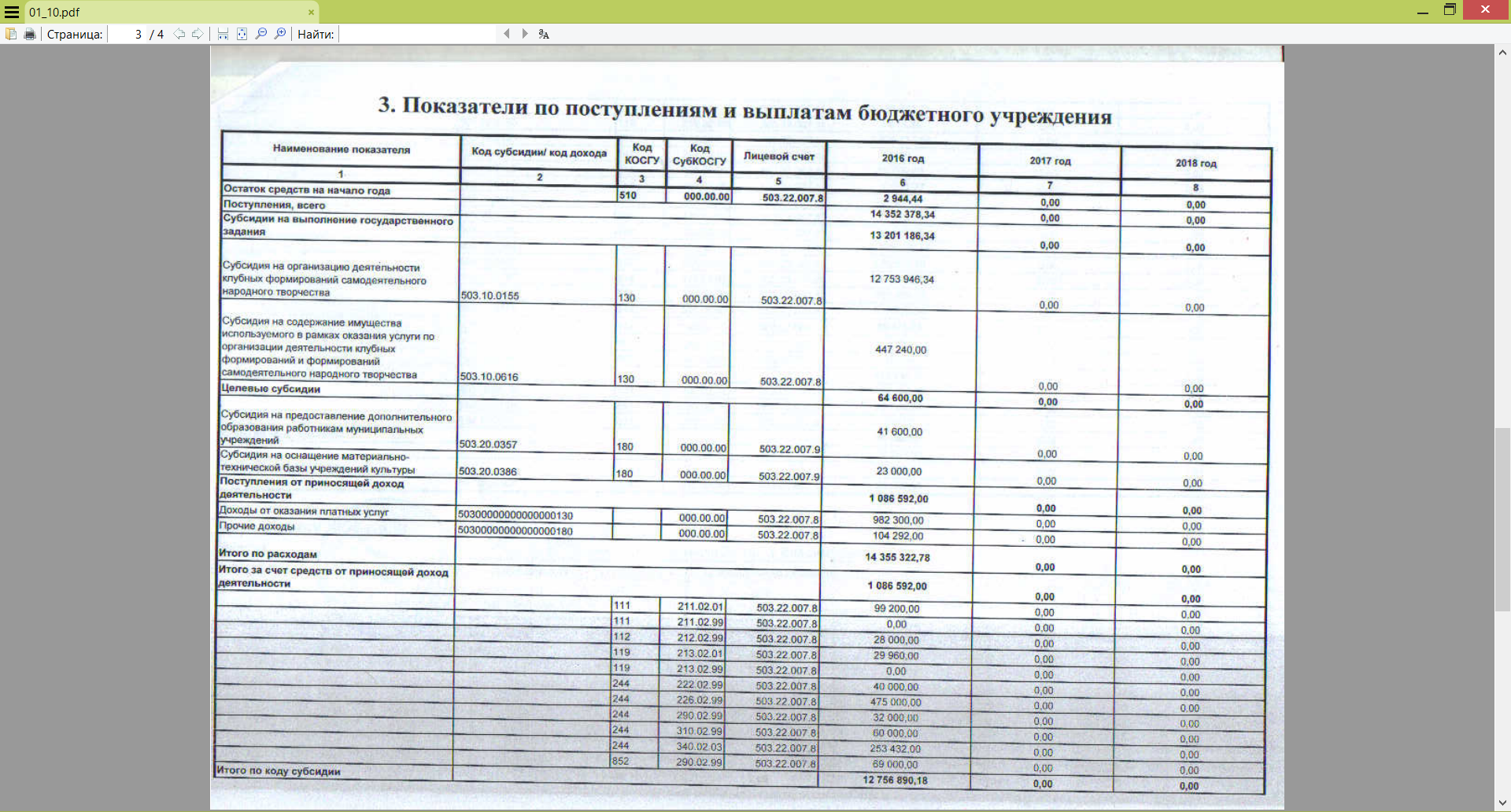
( — pdf) . , , . , , , , .
«, » (14352378,34 .), , « » . ! ?
« » «». , , , 4 ().
:

, ? -, . , , : , , , . 2 ( ) «» — , . -, : « » , .
4 226 ( ):
№ 1. , , 41600. « », « ». ( , — 503.20.0357).
№ 2. (503.10.0155) — « », : 12756890,18 12753946,34 , — 2944,18. , : , , ( « » — 2944,44). — , — - . : 2944,44 — 2944,18 = 0,60. 60 ? 503.10.0616 ( ): — 447240,60, — 447240,00, — 0,60 . : .
№3. , (« »), . (1086592 .) , . ? , . ( ) — . , , — 503 130 180. 503 — , — , 130 180 — ( ).
What conclusions can be drawn? . (№1 ), , . Why? « » ( 226) . , , , - , . .
?
1. .
2. : , , .
3. , . , « , », . — .
4. , , . , « »,
, ( — ), , ( — , ?).
/ / , ? , ( ) (, )?
. , . , .
, ?
, , … : ( ).
, , — . .
, . What's next? - , — . : / ; / , ; .
1. .
. — . ( ? — ). , , : — , , (, ).
2. , .
, , , , . , . , , , - , , … : ( ) ( ), . .
— 1.
3. , , .
. — 1, , , - . — .
4. .
This should not be. / , . , , , - . , . .
, .
1. , , , .
2. , , , .
3. , — . — .
4. ( ) — , .
5. .
- how the customer is going to spend money (44-, 223- and other terrible abbreviations);
- again open data;
- once again about promises and their absence;
- what causes inattention;
— ;
- technical problems pitfalls;
— ;
- and much more.
PS Naturally, the author does not bear any responsibility for any losses incurred by you, your family, friends, colleagues, pets, your organization, your contractors and all other third parties, as a result of your inaction or any actions performed as influenced by this article, without taking it into account, in accordance with the stated material or in spite of it.
Chapter 0. Boring, but necessary
Initially, the article was planned as a kind of memo about some of the features of working with budgetary institutions for small IT companies or IT specialists who are individual entrepreneurs, but in the process of writing it turned out that the scope of questions concerned is too wide for both the format of the memo and the format of one article .
With high probability there could be two options:
1. The memo is short and tezisnaya, but understandable only to those who have sufficient training in this area ... and quite useless for all (or almost all) others.
')
2. An article containing an introductory course covering some issues of the legal status of institutions, procurement legislation, civil law, etc., filled with details and background information, examining the issues raised from different points of view and taking into account numerous development options events, but ... lost its relevance in the process of writing (even difficult to imagine how long it will take), swollen to disgrace and causing the overwhelming majority (including the author himself ) Desire to immediately close a tab, and in the few readers pereborovshih this impulse - a sense of irresistible boredom after reading the first two or three chapters.
To avoid this and make the material useful and readable for many, several volitional decisions were made:
1. Do not try to encompass the immense: if one article is not enough to manage - let it be a cycle of articles. The main goal is to give the most clear and realistic representation of the features of working with budgetary institutions; therefore, a detailed explanation of some related issues will have to be neglected and some information should be given as an axiom (or consider such issues in separate articles).
2. Gradualism is the basis of the basics: many questions require, of course, a comprehensive review, but it’s impossible to tell everything at once. Therefore, we will move in stages (article by article), periodically referring to what has already been stated, inevitably simplifying and coarsening something.
3. Boundary conditions: an attempt to describe as many scenarios as possible depending on the type of customer, cost and type of work, some other circumstances looks very tempting, but this is simply unrealistic, therefore we will sometimes move from the particular to the general, and sometimes and vice versa. All that goes beyond the boundary conditions, try to consider another time, actively using comparisons and analogies.
As a result of the above-described volitional decisions, instead of one article, so far we have received a
Who can it all come in handy? Those who work (or are only going to work) with budgetary institutions.
Will the information be useful for those who work:
1. Under the fixed-term employment contract with a budget institution?
Hardly: in this case, the main role is played by labor legislation. But in order to expand the horizons - why not read?
2. With a budget institution, but whose activities are not related to IT?
Yes. Much of the work with budgetary institutions does not depend on what exactly you are doing, but everywhere there is a specificity and some points relate exclusively to the sphere of IT - keep this in mind.
3. Not with a budget, but with a government, autonomous institution, or even an executive body or local government?
Yes, there is a lot in common. In order not to be constantly distracted by clarifying what kind of customers we are talking about, which would only complicate both writing the article and reading it, it was decided to consider the features of working with them in a separate comparison article (if it will be interesting to readers).
4. Not with a budget, but with a commercial institution?
Information will be useful since the second half of the second article, but still have to take into account the specifics.
5. With a budget institution, but on the basis of an agreement concluded as a result of an auction, tender, request for quotations, request for proposals?
Yes, much of the information will be relevant, but in this case, the specifics associated with the organization, conduct and participation in competitive procedures are added, and, conversely, the process of agreeing the terms of the contract almost disappears. There is a non-zero probability that some interesting points will be considered in a separate article.
Do not forget that each situation is unique in its own way, and to draw analogies, despite the possible similarities (real or only apparent), you must be very careful.
Article is my first publication on Habré, and, accordingly, the first article of the subject concerned. I do not know how much the raised topic will be in demand, so if: you are interested in something; a question has not been considered in sufficient detail and requires additional explanations; you strongly disagree with something - please write in the comments or through personal messages.
It is a little about the author and the reasons for writing the article: I am a longtime reader of Habr, but, as it happens, I registered only now. For all this time, a lot of information was gathered from Habr, which turned out to be not only interesting, but also useful: for professional activities, and for various hobbies, and even for some domestic needs. This information was so much that the recurring idea that it would be nice to somehow “give up” (I don’t like to remain in debt), at some point transformed into an article you see.
Answers to some possible questions are given under the spoiler at the end of the article. Also, under the spoiler, some images have been removed (mostly, visualizing the description of the navigation through the menu of sites) and information: reference (excerpts from the text of laws and other documents) and not related directly to the topic of the article, but related to it.
Chapter 1. Who are we dealing with?
So, the promised boundary conditions: we will be a budget institution as a customer, a small (or large) company or an entrepreneur as you, software development will be the subject of the contract, and the contract itself will be concluded directly with you, and not as a result of tender, auction or request for quotations (competitive methods of procurement is a topic for a separate conversation), the cost is approximately known, and even the task does not cause any special questions (at first glance).
How to find out the TIN by the name of the customer is not a secret, but for the sake of completeness, this is worth mentioning. The website of the tax inspectorate egrul.nalog.ru can be searched by TIN / OGRN or by the name of the legal entity (IP). Let our customer - the Lower Sortyim Children's Art School Municipal Budget Institution (this and other institutions are completely random and are used solely for the purpose of example).
Choosing the type of search, entering the desired name and captcha, we get the following picture: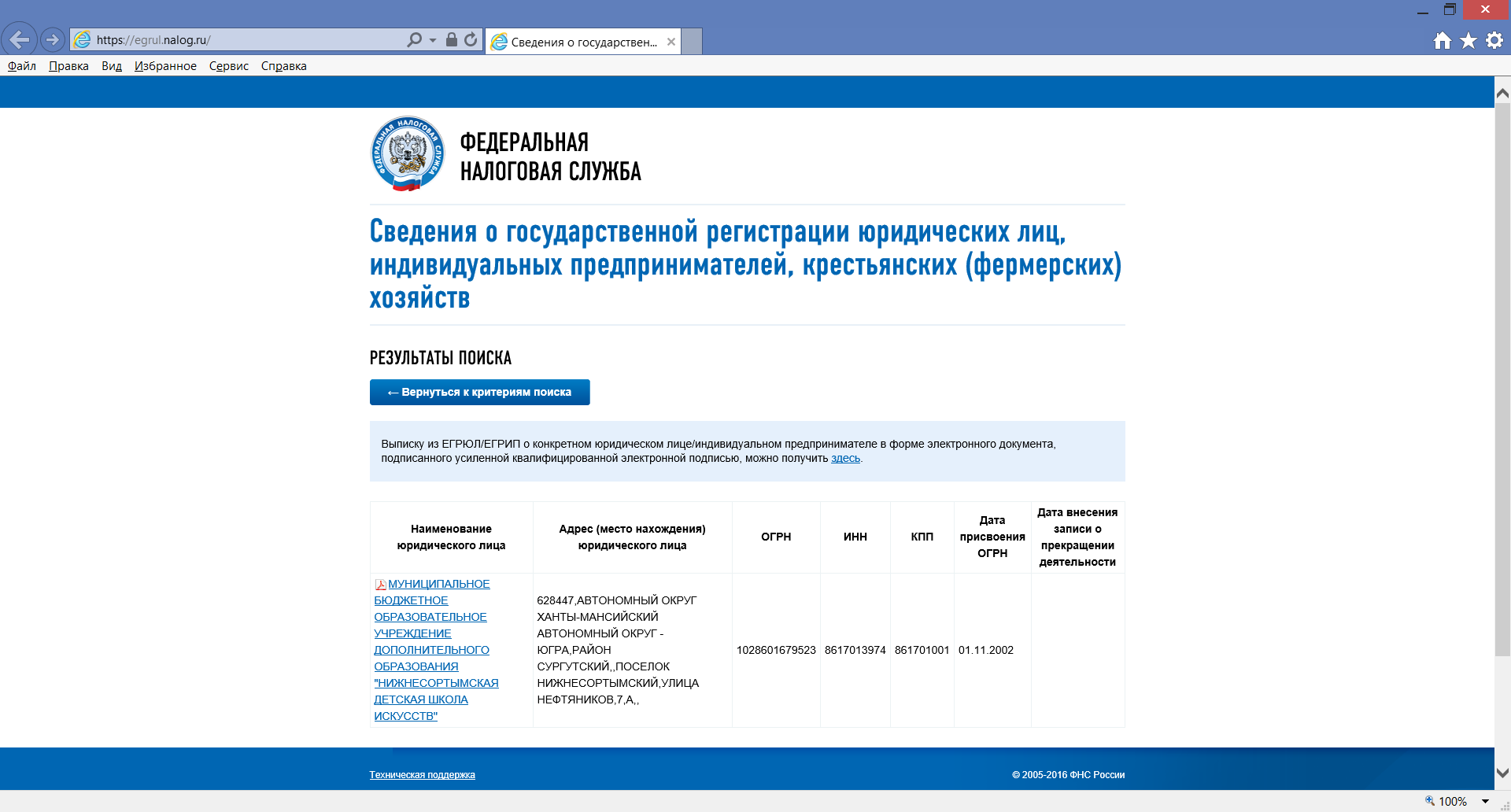

By clicking on the name of the institution, you can download an extract (.pdf). Usually, the most interesting is contained on the first three or four pages, but nobody forbids to view them all.
The first three pages of the statement: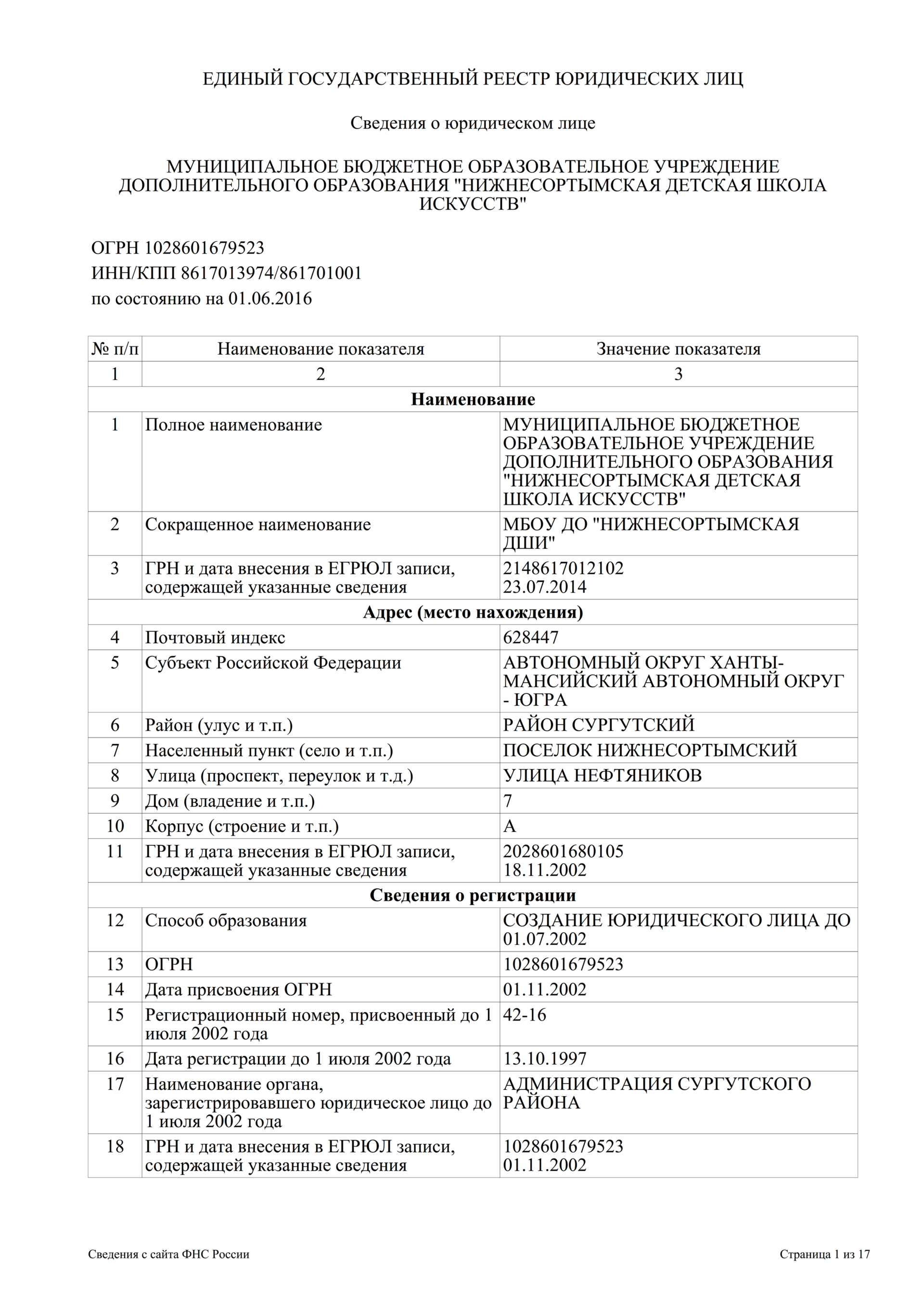

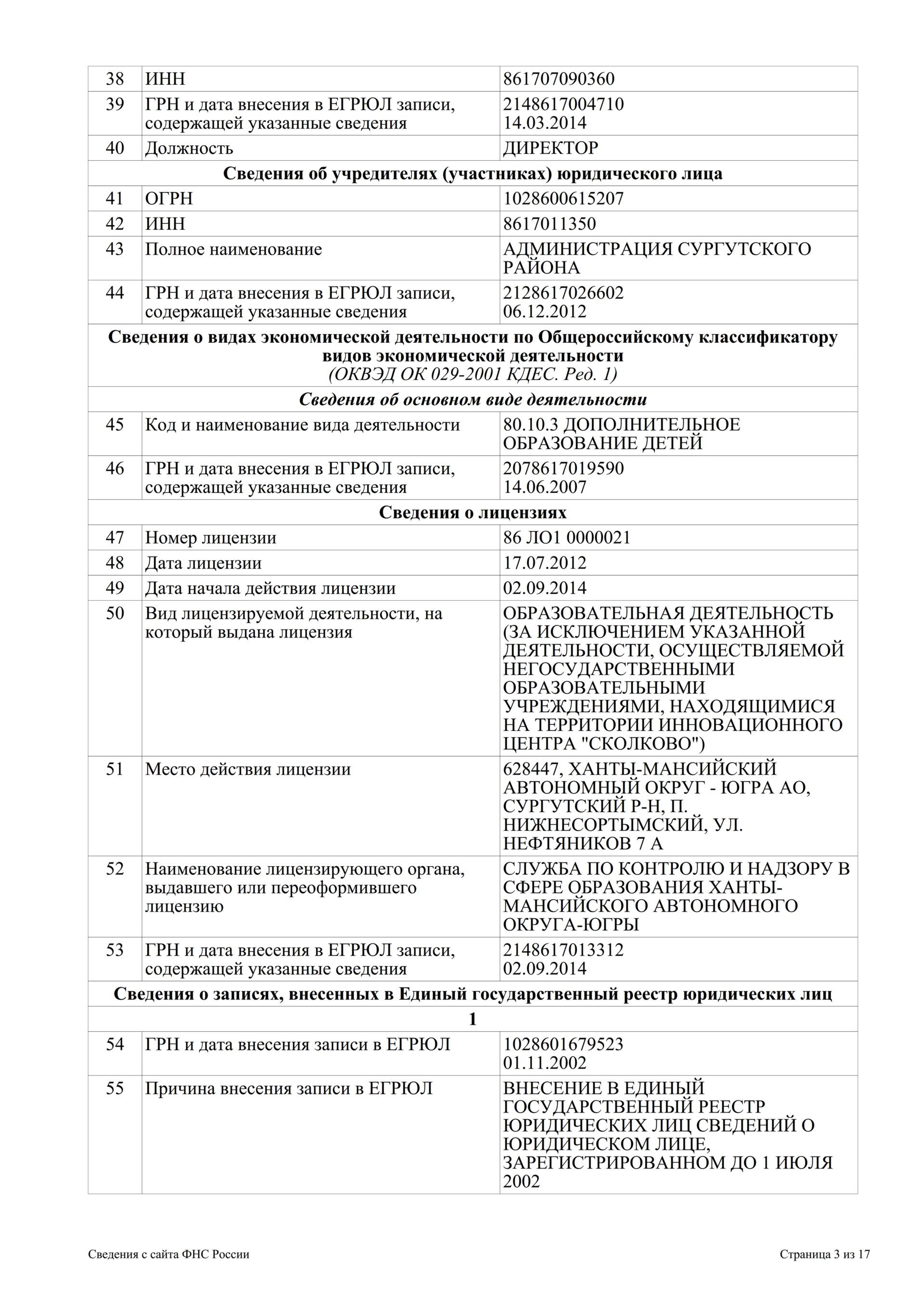



Now we have the TIN of the customer (8617013974), the full name of the director, address (location), founders, activities (OKVED), licenses, and so on. Why do we need this?
INN - we will use it for further search queries.
Director’s full name - in order to know with whom we must conclude an agreement (in the third article of the cycle about the importance of having a person concluding an agreement with appropriate powers and possible unpleasant consequences).
Address (location) - firstly, it is always useful to know where the customer can be found (and if the nature of the work you do is related to the physical visit of the customer, then it’s not just useful, but necessary), secondly, we may need this address for exchange of correspondence.
The founder is a higher authority for our customer, and in some cases it will be useful to address there with those problems that the customer cannot or does not want to solve.
And if you want to know more? There are other sources of information, for example, the official website for posting information about state (municipal) institutions bus.gov.ru/pub/home .
Enter the TIN in the search field, hover the cursor on the name of the institution and get:

Choose "Detailed Information":

Just in case, I provide a link for independent viewing: bus.gov.ru/pub/agency/3071 . On this page are the name of the institution (full and abbreviated), founder, type of institution (do we still remember that we work with a budget institution?), Address, name of the manager, phone number and even a website (of course, the customer’s site does not always have ).
Open the "Documents" section:

Here are the Charter of the institution, a license for educational activities, an order appointing the director and other documents.
Is this helpful information? Yes of course. In addition to the data obtained from the tax inspectorate website, we now know the type of institution: usually in the name of budgetary institutions there is the word "budget" (the letter "B" in the abbreviation), but it may not be - the law is not prohibited. We also have a Charter where you can gather information about the powers of the institution and its founders, about sources of financial support and other details. The order on the appointment of a director is also a useful document.
Possible problems: not in all institutions (read, municipalities and even regions) due attention is paid to the timely updating of information.
Some details about this site:
Also here you can get information about the state (municipal) task, plan of financial and economic activities, operations with targeted subsidies, annual financial statements, performance results and much more.
Information about the site itself can be found in the section “Main Menu - Documents” (and then in the submenu select “TFF Albums”, “User Guides” or something else to your taste). Open data sets are in the section “Main menu - Open data”. For more information about the customer, you can use his website (if available) or counterparty checking services.
Information about the site itself can be found in the section “Main Menu - Documents” (and then in the submenu select “TFF Albums”, “User Guides” or something else to your taste). Open data sets are in the section “Main menu - Open data”. For more information about the customer, you can use his website (if available) or counterparty checking services.
Chapter 2. Where does the customer have the money?
It would seem, what difference does it make to us? If only to pay on time and in full. But this is in theory, but in practice - the source of funding or the source of financial support (as it is called officially) is very important. No one wants to be in a situation where the work is done and successfully delivered, and no one is in a hurry to pay for it. All the variety of reasons for the customer (non-financing costs, took the money for other needs and another 1000 and one) should not be a problem performer. We will talk more about payment issues in the following articles, but for now let's see what you can find out about the presence / absence of funds from the customer.
The budget institution has two main sources of financing: the “budget” and the “extra budget”. The definitions are not entirely correct - therefore in quotes.
The “budget” is the money that the state allocates (yes, the author is aware that local governments are not included in the system of state authorities, but this is easier than writing FOIV, OIV and LSG every time): it can be the budget of a settlement , municipal district, region, region, etc. For budgetary institutions, the main sources of budget funds are subsidies for the implementation of the state (municipal) tasks and subsidies for other purposes.
"Off-budget" is that the customer earned himself: his income from business and other income-generating activities.
And why do we need this? If you are going to work with a budget institution, you need to understand the following:
The “budget” is not real cash held by the customer in the accounts and which he can pay “right now, right now.” These are only planned (and not always) expenses. In other words, for now this is only a promise of the state to give this money to the customer. A promise can be taken back (not to give money) or reconsider (reduce the amount or change its purpose). A customer can try to resist this in an extremely limited number of cases, and even then without a guarantee of success.
"Off-budget" is also not always cash. Sometimes, of course, the customer already has money, but often he still has to earn it, and then this is again a promise: only now it is a promise not of the state, but of the customer. A promise can be ... However, we will not repeat.
The main financial document for a budget institution is the Financial and Business Plan or, in abbreviated form, the PCD plan (there are also agreements on the allocation of subsidies and other documents, but they have nothing to do with our subject). It is signed by the head and chief accountant of the institution, it is approved by the founder, and it contains the promises (of the state and the customer), which we discussed above.
Let us return to the official site already familiar to us for posting information about state (municipal) institutions. If the menu with information about the institution choose
"Planned performance indicators - Information on the financial and economic activity plan",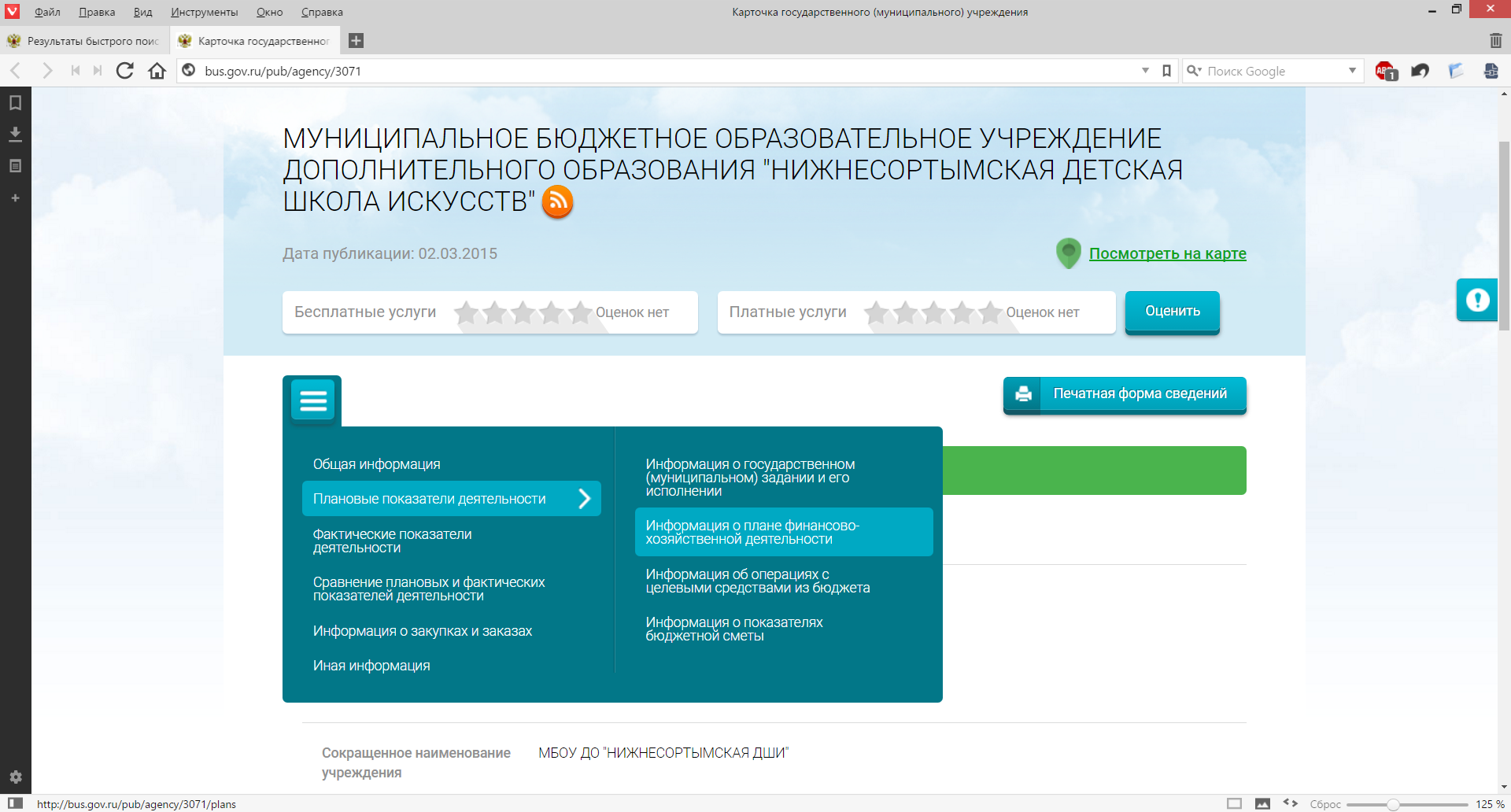

then we will fall into the section on the PCD plan: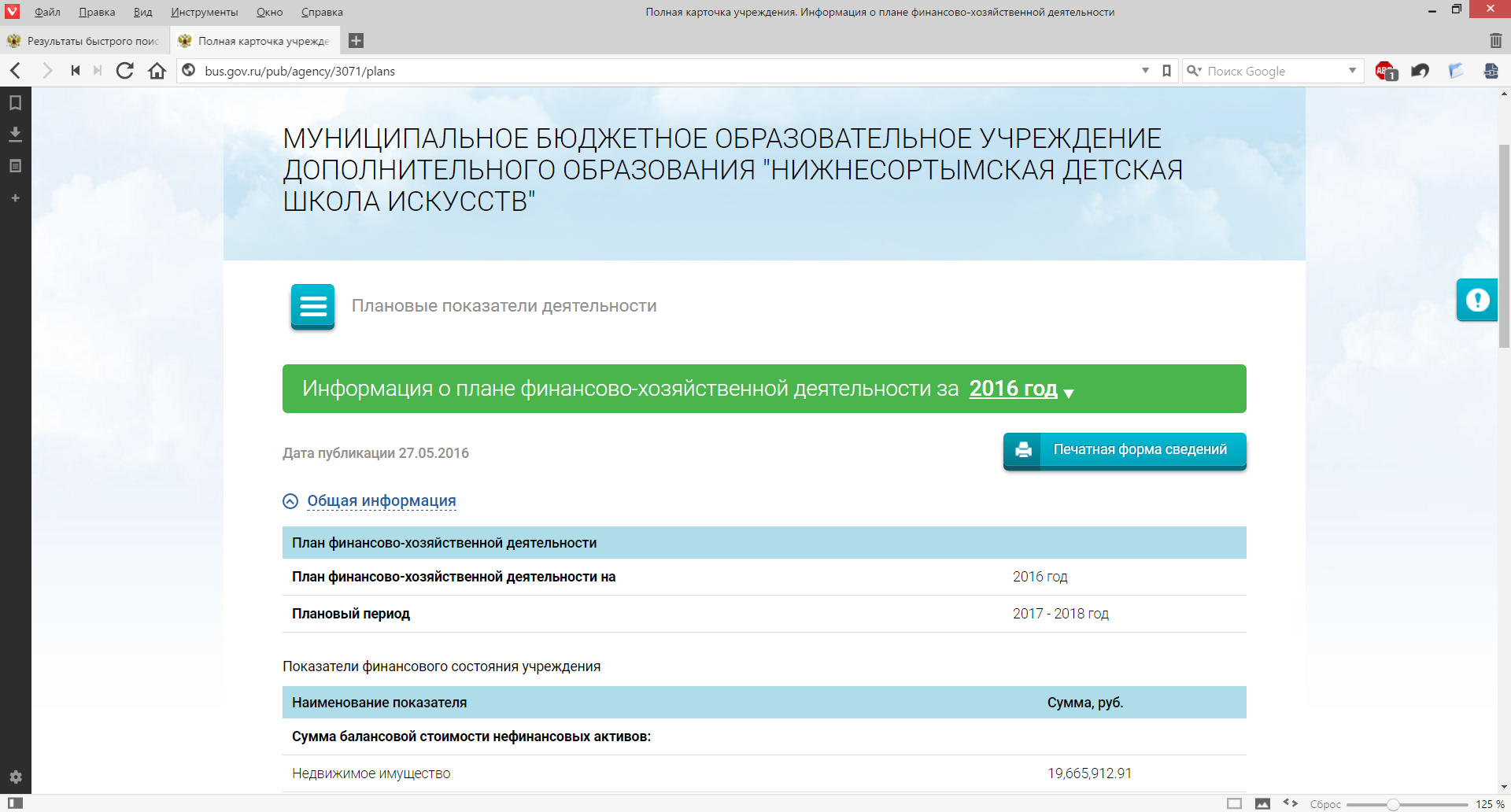

In the section "Documents - Attached Documents" we see several files: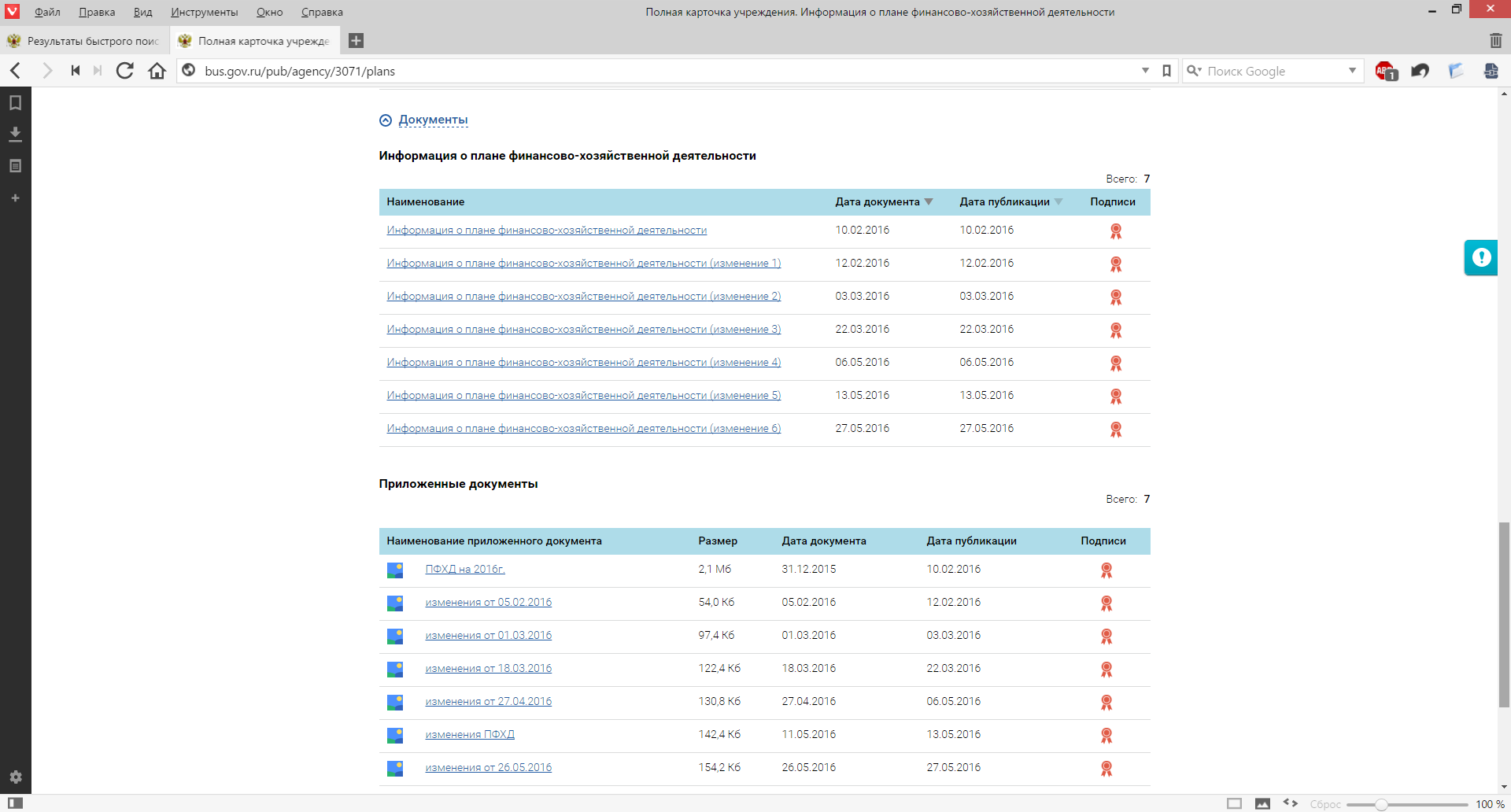

Download the latest version of the Plan of financial and economic activities (we are guided by the date of publication, at the time of this writing, the latest version of 05/27/2016).
In this case, we deal with the .xlsx file (in principle, we could get both .doc, and .pdf, and even .jpg), in which on the sheet “Meas (8)” is the current version of the plan of financial and economic activity:

The income section (starting from line 22) reflects the sources of financing, from which the customer plans to receive money (I emphasize that he plans). Lines 24 and 27 contain information on subsidies for the implementation of municipal tasks and subsidies for other purposes (this is the “budget”).
How do these types of subsidies differ? Directly with the topic of the article is not connected, so who cares - I ask for a spoiler.
A little bit about subsidies:
In theory, subsidies for the implementation of the municipal task should ensure the everyday regular needs of the institution (payment of wages, payment of utilities, communication services, garbage collection, etc.), without which it cannot exist. For example, an institution must train 10,000 children, or issue 50,000 certificates. For this he needs 50 million rubles a year. This should be provided for by a grant to fulfill the municipal task. Subsidies for other purposes are designed to meet those needs of the institution that arise irregularly, are unplanned (for example, emergency roof repairs), or are necessary to improve the quality of something: for example, modernization of the heating system, scheduled repairs to the roof and premises, purchase of new equipment in return outdated and more.
In practice, of course, occurs in different ways. As a rule, subsidies for the implementation of the municipal task do not fully meet the needs of the institution, and part of the funding is provided (if at all) through subsidies for other purposes. It happens the other way around: when expenses that should be financed by subsidies for other purposes are included in the subsidies for the implementation of the municipal task. Of course, there are also happy institutions that do not deny themselves anything, but there are few of them. Also, within the framework of subsidies for other purposes, the institution may receive funds for any federal, state and municipal programs.
In practice, of course, occurs in different ways. As a rule, subsidies for the implementation of the municipal task do not fully meet the needs of the institution, and part of the funding is provided (if at all) through subsidies for other purposes. It happens the other way around: when expenses that should be financed by subsidies for other purposes are included in the subsidies for the implementation of the municipal task. Of course, there are also happy institutions that do not deny themselves anything, but there are few of them. Also, within the framework of subsidies for other purposes, the institution may receive funds for any federal, state and municipal programs.
Line 29 is the income from entrepreneurial and other income-generating activities (in the subsequent lines there is a detalization), or “extrabudget”.
So, the promises of the state ("budget") - 24042309,13 rubles., The promises of the customer ("off-budget") - 1466280 rubles. A natural question arises: which source of funding is more profitable from the point of view of the performer? There is no exact answer.
The amount of subsidies for the implementation of the municipal task is known, as a rule, from the beginning of the year (it is known to someone in advance, and someone can know for sure their funding, for example, in March), should not change and can not be reduced (although the Prime Minister and said recently that unused money should be taken away), but in practice it happens quite often due to the fact that there is no money.
Subsidies for other purposes have a little more security when they have already been promised (read - they issued a corresponding order or decree), but if they have not yet been issued, they can easily go to other needs or to another customer. If this is a subsidy from a higher budget, then someone can be punished for the non-appropriation of the allocated funds, so they are trying to pay them promptly - again, if there is money.
The customer also needs to earn money from business activities, and in a crisis situation with the “budget”, institutions often have to plug holes in the “extra-budget”. , «» , , , , ( , ).
, , , . - , ( : ), (, ). , , . , .
3. ?
, , — . , , .
— ( 1 2013 . N 65 « »). , , base.garant.ru/70408460/5 , ( «»). , :
1) — 225;
2) — 225;
3) — 310;
4) — 340;
5) — 226;
6) — 320.
:
225: « , , ( , () , ), , , , , , , :
( ) :
— ( ) , (, , ..), ;
— - ( , , , , ..) ;
;»
310: « , () () , , () , , , , , ( ) , , , , :
— ;»
340: « () , , :
— () , , , , , , , - , ..;»
226: « , , 221 — 225, :
:
— (), ;
— - ;
— - ;
— ( ) ;
— ( .. ) () , , ;»
320: « , , :
— ».
( ) :
— ( ) , (, , ..), ;
— - ( , , , , ..) ;
;»
310: « , () () , , () , , , , , ( ) , , , , :
— ;»
340: « () , , :
— () , , , , , , , - , ..;»
226: « , , 221 — 225, :
:
— (), ;
— - ;
— - ;
— ( ) ;
— ( .. ) () , , ;»
320: « , , :
— ».
, , . : , ; ( ); .
: , — 320, ( , , ), 226. 226 . , .
, . , ( 225), ( 310), ( 226). , , , , , , — .
4. ? - 2
: , — 226.
. «» ( 47) :

«O» . , ( «F»).
, (, , — ), ( ), «» «». , 226 ( 65). , , .
.
( , ). — 5514008737. , :

( — pdf) . , , . , , , , .
«, » (14352378,34 .), , « » . ! ?
« » «». , , , 4 ().
:

, ? -, . , , : , , , . 2 ( ) «» — , . -, : « » , .
4 226 ( ):
| № / | 4 ( ) | 2 ( ) | 6 ( 2016 , .) |
| one | 226.02.99 | 503.20.0357 | 41600 |
| 2 | 226.02.99 | 503.10.0155 | 991000 |
| 3 | 226.02.99 | - | 475000 |
№ 1. , , 41600. « », « ». ( , — 503.20.0357).
№ 2. (503.10.0155) — « », : 12756890,18 12753946,34 , — 2944,18. , : , , ( « » — 2944,44). — , — - . : 2944,44 — 2944,18 = 0,60. 60 ? 503.10.0616 ( ): — 447240,60, — 447240,00, — 0,60 . : .
№3. , (« »), . (1086592 .) , . ? , . ( ) — . , , — 503 130 180. 503 — , — , 130 180 — ( ).
What conclusions can be drawn? . (№1 ), , . Why? « » ( 226) . , , , - , . .
?
1. .
2. : , , .
3. , . , « , », . — .
4. , , . , « »,
« »:

, ( — ), , ( — , ?).
5. (-!)
/ / , ? , ( ) (, )?
. , . , .
, ?
, , … : ( ).
, , — . .
, . What's next? - , — . : / ; / , ; .
1. .
. — . ( ? — ). , , : — , , (, ).
2. , .
, , , , . , . , , , - , , … : ( ) ( ), . .
— 1.
3. , , .
. — 1, , , - . — .
4. .
This should not be. / , . , , , - . , . .
, .
Conclusion
1. , , , .
2. , , , .
3. , — . — .
4. ( ) — , .
5. .
- how the customer is going to spend money (44-, 223- and other terrible abbreviations);
- again open data;
- once again about promises and their absence;
- what causes inattention;
— ;
- technical problems pitfalls;
— ;
- and much more.
PS Naturally, the author does not bear any responsibility for any losses incurred by you, your family, friends, colleagues, pets, your organization, your contractors and all other third parties, as a result of your inaction or any actions performed as influenced by this article, without taking it into account, in accordance with the stated material or in spite of it.
:
1. Are the methods considered mandatory, necessary and sufficient?
. The author of the article offers only a few more tools for obtaining additional information that may be useful when making decisions about working with a customer. , , — .
2. , ?
. , . For someone contract for 100 thousand. Rub. - a trifle in the general flow of contracts, and for someone - a very serious and responsible event. Someone prefers to defend their interests in court (and has extensive experience in this), but for someone it is easier to solve issues in the pretrial order. Someone is ready to prove anything in any court - and therefore does not bother with drawing up detailed terms of reference or honing the wording of the contract, and someone prefers that every little thing is documented. People, organizations, situations - different, the required labor costs - too. Therefore, it's up to you.
3. It may be easier not to work with budgetary institutions at all?
Firstly, we here consciously consider the situation from the point of view of possible problems. Secondly, who said that it is easier to work with commercial institutions? There, too, there is such an array of difficulties that Mama Do not Cry. And thirdly: "If you do not have a home, fires are not terrible for him ...".
4. Does the article state the truth, the whole truth and nothing but the truth? Errors can not be?
-, . Secondly, legislation tends to change, and often at a rather rapid pace. Thirdly, it is impossible to foresee all the circumstances within the framework of the article: it is required to study a specific situation. -, , , — . -, - .
In any case, if you are confused by something, write about it in the comments or through personal messages: it depends on how much the information presented in the article will be accurate, relevant and multilateral.
5. ( )?
Maybe a lot. Write to the author, and if thestars are positioned as needed, there will be time, opportunity, strength, and, most importantly, information on the question you are interested in - why not.
. The author of the article offers only a few more tools for obtaining additional information that may be useful when making decisions about working with a customer. , , — .
2. , ?
. , . For someone contract for 100 thousand. Rub. - a trifle in the general flow of contracts, and for someone - a very serious and responsible event. Someone prefers to defend their interests in court (and has extensive experience in this), but for someone it is easier to solve issues in the pretrial order. Someone is ready to prove anything in any court - and therefore does not bother with drawing up detailed terms of reference or honing the wording of the contract, and someone prefers that every little thing is documented. People, organizations, situations - different, the required labor costs - too. Therefore, it's up to you.
3. It may be easier not to work with budgetary institutions at all?
Firstly, we here consciously consider the situation from the point of view of possible problems. Secondly, who said that it is easier to work with commercial institutions? There, too, there is such an array of difficulties that Mama Do not Cry. And thirdly: "If you do not have a home, fires are not terrible for him ...".
4. Does the article state the truth, the whole truth and nothing but the truth? Errors can not be?
-, . Secondly, legislation tends to change, and often at a rather rapid pace. Thirdly, it is impossible to foresee all the circumstances within the framework of the article: it is required to study a specific situation. -, , , — . -, - .
In any case, if you are confused by something, write about it in the comments or through personal messages: it depends on how much the information presented in the article will be accurate, relevant and multilateral.
5. ( )?
Maybe a lot. Write to the author, and if the
UPD. 2016.06.19
1. Added link to the next part.
2. Fixed a typo.
3. The name of the block “In the next series” has been changed to “In the following series”: it is not always possible to fit everything that was planned into the article.
2. Fixed a typo.
3. The name of the block “In the next series” has been changed to “In the following series”: it is not always possible to fit everything that was planned into the article.
UPD. 2016.11.03
The link to the next part is replaced by the contents of the entire cycle.
Source: https://habr.com/ru/post/303360/
All Articles